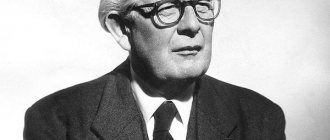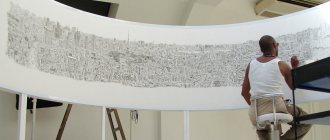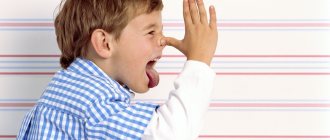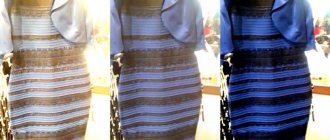Stages of preschool childhood
- junior (3-4 years);
- average (4-5 years);
- senior (6-7 years old).
Three periods of preschool age
Preschool childhood is one of the most dynamic and interesting periods from the point of view of the comprehensive development of the child.
During preschool age, a child makes a colossal “leap” in physical and intellectual development: all cognitive functions are formed and actively developed. The basis of this development is perception.
Period from 2 to 3 years: formation of lasting connections
By this age, the child has accumulated certain experience, it is already easier for him to recognize and distinguish between the objects that surround him. The connection between word and object is established much faster. From the age of two, children need only 4 repetitions to select an object by name. And the older the child gets, the more stable connections are formed between words and the differentiation of objects. Thus, as a result of observations, it was found that by preschool age, children, perceiving unfamiliar objects, are independently able to find their names by similarity to a symbolic object, for example, an oval - lemon, egg.
By the end of two years of age, a child is able to correctly name an object familiar to him, however, when identifying certain features, he may ignore individual details and make mistakes, for example, calling a tiger cub a cat and, generalizing objects based on various random features, calling them one word.
Perception of what it is
In psychology, perception is understood as the process of reflecting reality in all its interrelations. A person receives signals from the environment through various senses. From them, information enters the brain, where it is “processed” and “generates” sensations.
An important role in perception is played by a person’s activity, his speech and the “baggage” of accumulated life experience.
All this allows us to see not only the properties of individual objects, but also to perceive a full picture of the reality around us.
Sensory perception in young children
A person’s ability to perceive information, unlike the ability to do so, is not innate. When a child is born, he learns to do this. He sees objects, hears certain sounds, feels touch and smells. This is evidence of the formation of the perception mechanism. But the child cannot use it - he does not know how yet.
The meaning of perception
The importance of the perception process is difficult to overestimate. This is the basis of human knowledge, the foundation for its further development. Knowledge of the world begins with perception, which involves the inclusion of other mental operations: attention, thinking and memory. That is why it is so important to know its developmental features and be interested in this development.
A child’s understanding of the world begins with perception
Perception of the world in preschool age
Preschoolers are attracted to bright objects, melodic or original sounds, and emotional situations. They perceive the surrounding reality involuntarily, directing their attention to what attracts them most.
A child, seeing an object, is able to evaluate the functions known to him, intuitively analyze his experience and understand what he sees, hears or feels. A little baggage of life experience helps to understand what kind of sensation it is, to recognize an object, sound or smell.
The development of perception in preschool children allows them to move to the next step, when they learn to purposefully study objects, determine their characteristics, and differentially perceive individual properties.
What is a child's perception
Over the course of several preschool years, a child goes from directly perceiving an object through touch to the ability to isolate essential features and form a generalized idea of objects.
The function of cognition works as follows: perception arises as a reflection of a phenomenon or object using vision, hearing or touch.
Perception or perception is the process of receiving and transforming information using the senses, thanks to which a person develops a picture of the real world.
The perception mechanism can be briefly described as follows:
- The world around us consists of many signals: sounds, colors, pictures, tangible objects;
- By inhaling a smell or touching a piece of paper, the baby evaluates the object using one of the senses;
- This information enters the brain, where the sensation is born;
- Sensations add up to a complex “picture”, forming perception.
Perception is also influenced by previous experience. The senses help the child reduce information processing where he sees a familiar environment. Having received an idea of the toy bunny once, he will not need to touch or taste it again.
Perception is the basis for the further formation of cognitive functions necessary for full development and successful study.
Formation of sensation and perception processes
From birth, a child has what is called “sensory perception.” Smells, tactile sensations, and noise reach his brain, but the baby does not yet know how to use these signals. In the first years of life, children master object-related activities and accumulate information about the properties of objects, as a result of which sensory standards are formed.
From the age of three, perception gradually becomes accurate and meaningful. Higher analyzers – visual and auditory – develop.
The child cannot yet comprehensively analyze an object or phenomenon, but he grasps the most noticeable signs, involuntarily comparing them with standards and drawing conclusions.
From a general understanding of objects at 3-4 years old, the youngest preschooler moves on to more complex forms of interpretation. With the active support of adults, the characteristics of sensations change, the child manages to realize that shape, color, material, size are more abstract characteristics and are not tied to a specific object.
By the senior preschool age, the child becomes familiar with the basic figures of geometry, identifies all the colors, and learns to determine the sizes of objects. He also understands that there is time in the world - morning always turns into day, and then gives way to night. Awareness of space is an achievement - you need to walk from your house to the park, but the houses and trees stretch upward.
The importance of the development of perception in preschool age lies in the fact that with its limited functioning, the development of speech, memory, thinking, attention and imagination will be significantly hampered. This cognitive process becomes a necessary assistant for the manifestation of various types of thinking, the ability to speak figuratively and come up with vivid stories.
Features of development in the primary preschool period
Age is characterized by:
- active motor and play activities that allow you to interact with objects and learn their properties;
- the beginning of the use of speech and its active development.
All this serves as a catalyst for the development of all cognitive processes, and, in particular, perception.
Peculiarities of perception of children 3-4 years old
Objectivity of perception
- For children of this age, the properties of objects are still inseparable from the objects themselves. For example, a lemon is always yellow, and if a child sees a yellow fruit, he will be convinced that it is a lemon.
- When looking at images of objects, three- and four-year-old children fix their attention on one detail that stands out in size, color or shape, and from it they “infer” the entire object. For example, when a child sees a computer, he will most likely notice the larger part of it (the monitor) and decide that it is a TV.
Information and its perception in 3-4 years are only specifically subject-specific
Lack of clarity of perception
The perception of children of this age is somewhat “blurred” and lacks clarity. For example, children of this age do not recognize close and well-known people dressed in carnival costumes, even if their faces are “open.” Three and four year olds see the big picture, finding it difficult to analyze it and compare facts.
Parents (educators) are able to provide significant assistance in the development of the child’s perception, activating the process and directing it.
Peculiarities of perception in preschoolers
Main development tasks of the period
- To promote children's knowledge of new objects and phenomena.
- Teach children to manipulate objects in order to discover their properties, purpose, and features.
- Develop the ability to recognize objects and phenomena by their properties, compare, highlight similarities and differences, find features.
- Development of perception of the shape and color of objects.
- Help broaden children's horizons and develop their curiosity.
Please note: Throughout the preschool period, the main activity of the child is play, and it should become the basis of developmental work.
Types of perception in preschoolers based on perceptual systems
The main types of perception in preschoolers are based on various analyzers:
- Visual, allowing you to visually evaluate all the properties of an object;
- Hearing, which helps to learn speech, recognize the native language, feel the sounds of nature, hear music;
- Tactile, providing knowledge of an object through touch.
Auditory
With the help of hearing, the child learns to recognize the sounds of his native language, words and syllables. If in infancy the perception of speech is based on the rhythmic and melodic structure of words and sentences, then already at 1 year the formation of phonemic hearing begins. The baby needs another year for the acceptance of all the sounds of his native language to take shape and for the formation of a sound culture of speech to begin.
The development of auditory perception is most effective during walks, when the baby listens to the noise of the street, birdsong, the sound of rain, and steps. An excellent exercise is to close your eyes and try to understand from which side the bird is singing, or whether a car is driving far or close.
Visual
Visual perception is the leading one in preschool age. The ability to read, see the beauty of the world, and assess danger depends on it. Its leading role is justified by the fact that vision allows you to capture the entire object as a whole, as well as see details.
Visual signals arrive before the preschooler touches or tastes an object. In addition, examining an object is much safer than other methods of research.
Only at an early age, when the baby begins to comprehend the surrounding reality, his “eyes” are his hands. But at this stage, parents make sure that the child is in a protected space and that only safe objects are in his hands.
According to statistics, the number of visual people (who prefer visual perception) prevails in the world, so the development of this type requires special attention. The task of an adult in preschool age is to sharpen the child’s visual perception, and also to help him expand the range of perceived details.
With preschoolers you need to draw more, study pictures and illustrations. It is these children who enthusiastically engage in appliqué, putting together puzzles and mosaics, continuing to develop their visual senses.
Tactile
Tactile or kinesthetic perception is directly related to touch. Younger preschoolers still trust their hands even more when familiarizing themselves with a new subject. That’s why they so insistently ask to give them something that interests them. More details about tactile perception.
Playing with materials of different structures, modeling, natural substances is a great way to develop the sense of touch. With their eyes closed, children enjoy rolling the foil into balls and smoothing it out. Great joy comes from the exercise of identifying bulk material in a cup. The eyes, of course, must also be blindfolded.
Games that promote the development of perception of younger preschoolers
"Collecting droplets"
The game promotes:
- developing the ability to combine objects based on the presence of a common feature (color);
- development of color perception and fine motor skills.
Equipment: plastic containers in primary colors: red, blue, green, yellow. Each participant in the game has a set of colored circles of different colors.
Put the bunny in the carriage by color - game
Instructions: We ask the children to collect droplet circles into a glass of the same color.
"Hid under umbrellas"
The game develops:
- the ability to combine objects according to a common essential feature (form);
- perception of shape and color.
Equipment: illustrations of umbrellas in three (four) colors: red, green and blue. Triangle, square, circle for each child participating in the game.
Creating a game situation:
- “On a sunny day, the geometric figures went for a walk. Suddenly a cloud “covered” the sun and the rain started dripping. Where can our figures hide?”
- The children's expected answer: “Under the umbrellas.”
- "Certainly! Let all the circles quickly hide under the red umbrella, the squares under the green, the triangles under the blue.”
While playing, children learn to separate properties from an object by comparing them.
Perception disorders and causes
Development of perception in preschool children. Perception disorders are the inability to correctly perceive surrounding sounds and objects. Such a person is disoriented; he cannot really assess the reality around him.
The causes of perception impairment may be:
- pathology of the central nervous system, including due to diseases;
- mental disorders;
- reaction to taking complex medications such as antidepressants, antivirals and others;
- drug addiction, including congenital;
- trauma resulting in damage to the nervous system;
- physical and mental fatigue of the body;
- visual defect.
A child suffering from perception disorders needs to work with specialists who will create an individual program. But at the same time, the family can help solve the problem in the following ways:
Follow a daily routine
Get up and go to bed at the same time, eliminate those actions that cause fear and emotional stress.
Light
The child does not perceive the shape and color of objects well, and in poor lighting it becomes even worse. Therefore, the light should be bright, but soft.
Colors
So that the nervous system does not experience additional stress, it is necessary that the child’s room has as little gloss and ornaments as possible and as many solid colors as possible.
Daily activities to develop perception
Games to develop the ability to understand the size, size and shape of an object, as well as its color, and to develop sound and visual perceptions should be built taking into account the characteristics of children with disabilities. For example, you can offer to play such a game. It is proposed to insert an element of the same shape into specific puzzles. Of course, the child will not succeed right away, but over time he will experience small success. You can also use games that require tactile sensations. Playing with sand is also calming and develops fine motor skills.
Perception of children in the middle preschool period
Four and five year old children have already made some progress in the development of perception:
- basic shapes are easily recognized: circle, triangle, square, rectangle;
- know and distinguish 7 primary colors well;
- have an idea of the variability of color saturation: lighter or darker;
- know and use the division of color into warm and cold shades;
- understand soft and sharp combinations of colors.
Types and properties of perception
Perception of middle preschoolers
Peculiarities of perception of objects (phenomena)
By the age of 5, an idea of the size of objects and the ability to compare them is formed. Children of this period begin to use abstract concepts such as height, width and length when making comparisons. They can compare two or three objects relative to each other, using the concepts: “largest” and “more”, “average”.
Game for orientation in space “top-bottom, right-left”
Features of the perception of time and space
The perception of these quantities takes a long time to form in children. For middle preschoolers, it only “adds up.” As a rule, children remember the basic quantities denoting time intervals (hour, minute, today, yesterday, tomorrow), but do not yet know how to use them adequately. This is understandable: time is not subject to direct manipulation, and therefore all concepts associated with its designation are relative.
Time orientation is a difficult task for 4-5 year olds
For the same reason, a 4-5 year old child is not yet able to master the system of measures: centimeter, meter, kilometer.
Features of artistic perception
During the preschool period, all children are creators. They engage in artistic creativity, modeling, appliqué a lot and with great pleasure, and are interested in various types of design. For them, artistic creativity is a way of understanding the world, the ability to perceive feelings, and give birth to experiences. Children of this period are very emotional and the opportunity to create also plays a therapeutic role for them.
Peculiarities of perception of oneself and other people
The perception of people by children at this age is distinguished by evaluative judgments related to a person’s appearance and his moral qualities. For example, children may say about the teacher: “She is always beautiful (elegant).” About people who show warm feelings towards them: “She always hugs (kisses) me,” or “She is kind and affectionate.” Children speak especially emotionally vividly about those to whom they are most attached.
At 5 years old, for a child, the mother is the most beautiful and the youngest
Children's perception of peers depends on the child's popularity in the children's society (group) and his assessment by other children. We can influence this indirectly.
Tip: Show praise for your child's achievements at home. Thus, from early childhood you can lay an important foundation of self-confidence, which will be a good help when communicating in a group.
Game “Color + Shape” – for kids 5-6 years old
Features of the development of perception in a child
A preschooler perceives the world through active play, in which he learns and learns something new.
At a young age, preschool children cannot use their imagination; they use the knowledge they receive by using objects. So, if a frog is green, then for a child it can only be green. If an orange is orange, then another fruit of the same color is also an orange for the baby. Three-year-olds do not have a clear perception, they do not know how to analyze.
In the middle groups of kindergarten, pupils already have partial perception. They know colors, they know some geometric shapes, they can compare objects with each other in size and shape, but they do not understand time values. But they can and love to be creative. In many ways, getting to know the world and people for them is about accepting or not accepting appearance and character traits.
Older preschoolers already prefer to see than to hear a hundred times. Auditory perception lags behind visual perception. During this period, the child’s behavior and the qualities of his character are formed, so motivation is important when working with children of this age.
Games that develop the perception of middle preschoolers
"Bag of Secrets"
The game promotes the development of:
- the ability to recognize objects by their basic characteristics;
- based on tactile sensations, verbally describe the properties of an object.
Game “Guessing” or “What’s in the bag”
Equipment: an opaque bag made of any material, no more than 6 toys or just small objects made from different materials.
Instructions: choose a driver. He will have to guess the name of the toy (item) based on its properties. We invite one of the children to feel the toy in the bag with their hand and name its main properties. After the correct answer, the children change places.
“Whose sound is that?”
The game develops:
- auditory perception;
- the ability to recognize objects by certain properties (sounds).
Equipment: about 10 items made of various materials. This could be a spoon and a cup, a glass of water, a piece of paper, a plastic bag: anything that can produce characteristic sounds when manipulated.
Instructions: an adult hides behind a screen and makes sounds using objects: tears a sheet of paper, imitates the sound of stirring liquid with a spoon, crunches a plastic bag, knocks on the door, pours water from one container to another.
Children must guess which object each sound belongs to.
It is possible to complicate the task: children must name other objects that make similar sounds.
"Guess by the smell"
Game objectives:
- development of smell as a form of perception;
- consolidation of the ability to recognize objects by their essential characteristics (smell).
Game “Guess by smell” with closed eyes
Equipment: coffee beans, orange or lemon, perfume, essential oils with the smell of pine needles, strawberries and any other items with a characteristic smell.
Instructions: the driving child is blindfolded with a scarf and asked to recognize and name the object by its smell. If the task is difficult, you can use hints in the form of indicating other characteristic properties of this item.
Please note: Most preschool children draw a lot and enjoy drawing, and this can and should be used as one of the ways to develop perception. For example, the game “Guess by Smell” can be completed by asking children to choose the smell they like and draw it on paper using pencils or paints.
Child psychology
Rating 25When choosing forms, methods and methods of learning for a child, you should take into account the type of his perception |
- Type
- Ask
- Send to a friend
- Share
- subscribe to news
Our brain interprets the surrounding reality and receives useful information from it. Each of us has an optimal way of receiving information. Understanding how our child perceives information will help us develop his learning abilities. Research shows that 20-30% of people remember information through hearing, 40% through vision, and the rest remember best when they write down what they hear or apply the acquired knowledge in practice.
Types of perception
There are three types of perception - visual, auditory and kinesthetic (tactile). Organized children who love to read and notice details are visual types. Children who have well-developed speech skills, a penchant for learning foreign languages and musical talents belong to the auditory type. Children who like to act out and be physically active, use body language to explain things, and like to write are kinesthetic types. By observing a child, you can determine his type of perception - this will help parents and teachers maximize the use of different parts of the child’s brain in the process of his learning.
Children with visual perception
Children with a visual type of perception like to see the big picture of what is happening. They need the information to be presented in an attractive manner. They have well-developed visualization skills. These children should be exposed to fun activities that engage their speaking and reading skills. Link these activities to your child's learning by developing their vocabulary and pronunciation to improve their performance in school.
- Give your child a list of nouns, verbs, adjectives and pronouns that you will use in class. If at school your child is given a task to learn any words, add them to the list. Let your child choose colors for each group of words. Write the words on different colored cards.
- Invite your child to sort the cards by color.
- Invite your child to make sentences or coherent text from the words. This will teach a visual child to see the big picture and the end goal of the lesson.
- When your child can make sentences out of words, encourage him to make a story using all the words.
- Involve kinesthetic and auditory perception in the learning process: invite him to read the story out loud and act out a skit based on it.
Children with auditory perception
Auditory children perceive information better when something is explained to them in detail. According to research, auditory learners often talk to themselves, like to explain things to others, and have difficulty remaining silent for long periods of time.
Use their desire to talk when teaching auditory children. Offer them activities that involve speaking and listening skills.
- Talk to your child about his favorite food. Let him tell you all the reasons why he likes a particular dish. Ask what it tastes like and how the child feels about it.
- Help your child find a recipe for this dish on the Internet or in a cookbook. Make a copy of the recipe for your class.
- Encourage your child to read the recipe aloud to develop their auditory comprehension.
- As your child reads the recipe, encourage him to circle the words he liked from the text with a colored marker.
- Encourage your child to measure out the required amount of ingredients to prepare the dish. Describe the entire process out loud.
- Before trying the food, give your child a pen and paper and encourage him to describe his cooking experience. Thus, his auditory perception will be combined with kinesthetic perception. If a child illustrates his text, the visual channel of perception will also be involved.
- Invite your child to serve the prepared dish to all family members. At the same time, he must tell how the dish was prepared and whether he liked cooking it.
Children with kinesthetic perception
Kinesthetic children cannot sit still and constantly play outdoor games. Children with kinesthetic perception are considered difficult students because they are too active. But in fact, for successful learning, you need to include movement in this process.
Use games to teach a kinaesthetic child. Combine gameplay with learning modules (which may include new words or historical dates). During the game, the child will better remember the material and also enjoy the game itself.
- Choose the names your child needs to learn and have him write them down on cards. It’s especially good to learn new words this way.
- When your child writes down the words, invite him to read them out loud and write them with his finger in the air or on the surface of the table - this way the brain remembers the information better. On the back of the cards write tasks: “show”, “draw” or “explain”.
- After this, give your child a short break so that he can better concentrate on the game.
- Prepare everything you need for the game: notebooks, pencils, markers, etc.
- Invite your child's friends or family members to play. Shuffle the cards and invite your child to draw one of them. He must show, draw or explain the word written on the card without saying it. The rest must guess what word is written on the card.
- Allow players to change until all the words have been guessed. If your child cannot sit still while someone else is playing, find a place in the room where he can move around without disturbing others.
Understanding your child's perceptual characteristics gives you additional opportunities to find the optimal way for him to learn without exposing him to frustration. Use activities that work best for your child. This will help him learn better and strengthen your bond with him.
Rate this publication
Article rating: 5.00
out of 5 based on
5
ratings.
Related links:
- ▶ If your child is a visual learner, what does that mean?
- ▶ How to develop a child’s phonemic awareness
- ▶ We develop children’s spatial perception
- ▶ How to make your child’s learning effective
- ▶ More articles about the psychology of children and adolescents
Child development 01/03/2018
Age-related characteristics of perception of older preschoolers
- Dominance of visual sensations: six and seven year old children remember information “with their eyes”, which is why it is so important for him to see what he is told about.
- Sufficiently high auditory sensitivity: children easily recognize familiar pieces of music, feel the rhythm and tempo. However, auditory perception is weaker than visual perception and it still needs to be improved.
- Features of self-esteem: as a rule, it is somewhat overestimated and this is not scary, moreover, this is normal for this period of life. The main thing is that people around the child know this feature, understand and accept it. This does not mean that the child needs to be constantly praised or turn a blind eye to his age-related boasting. Criticism is necessary, but it needs to be conveyed in such a way that the child does not feel offended. It is important not to knock down your positive self-esteem. To do this, instead of the phrases “you didn’t…”, “you didn’t try”, it is better to say: “you did it, but...”, “you tried, but...”.
Educational building blocks for children aged 5-7 years
An important fact in the development of adequate self-esteem is the use of a situation of success. For this purpose, the child should be offered only those tasks that he is able to cope with due to his age or characteristics. Only in situations of success can one develop adequate self-esteem and confidence in oneself and one’s abilities.
- In older preschool age, behavioral standards are formed. During this period, the participation of adults in the child’s life is important: by reading and discussing what he has read and the actions of people around him, the adult forms their emotional attitude towards others, his own position or point of view by which he will compare his behavior and evaluate the actions of others.
- A new development of age is the appearance of arbitrariness. A six or seven year old child is able to set goals for himself and consciously strive to achieve them. The appearance of this quality has a positive effect on his overall cognitive development.
- Another important acquisition of this age is the emergence and development of cognitive motivation, which gradually replaces play motivation. A successful change in the leading motives of behavior indicates the child’s readiness to begin a new, no less significant stage in his development, to study at school.
Cards “Name what is drawn” for children 6 years old
When preparing for such a responsible transition, you need to take stock: assess the development of perception. Methods proposed by psychologists will help with this.
Peculiarities of perception in children of senior preschool age
Auditory perception
Preschool auditory learners need to be given information in the form of audio recordings. You can sing individual sounds, syllables, and listen to CDs with educational texts.
A child’s auditory perception develops well on street walks; it is useful to invite children to listen to sounds, identify the noises and signals of cars, airplane noise, etc. You can ask to distinguish noises with your eyes closed. For example, you can determine whether a car is moving or standing still. Is the car far away or close?
Visual perception
Visual children need to be given more visual information, pictures, and illustrations. While learning to read, you can draw letters, act out scenes with fairy tale characters, and show videos.
Since vision in visual children is the main means of perceiving information, special exercises should be selected for this.
Selecting teaching materials, various mosaics and construction sets is an important way to convey educational information to children. Exercises for the development of visual perception include such as “Fold the pattern”, Dienesh blocks and others. If you use mosaics or puzzles, the parts must be of the optimal size.
Visual gymnastics is a must. It is carried out 3 times a day. The duration of visual exercises is 3-5 minutes. The exercises need to be varied, they must be in a playful form, so that children are emotionally pleased to perform such exercises. Visual games and exercises help improve blood circulation and correct visual processes. You can also use special simulators for this.
Child's tactile perception
A kinesthetic child should draw or, better yet, sculpt letters from plasticine.
To develop a child's tactile perception, you can invite him to explore various natural materials or different objects with a different structure. As a rule, children are good at distinguishing objects by touch by shape and size.
Children of senior preschool age enjoy playing with foil. With their eyes closed, they must first crumple the foil, roll it into a ball, then smooth the foil.
A very interesting exercise is to determine what is inside the ball. Each ball contains various substances - water, flour, sand, peas, various cereals (semolina, rice, buckwheat). Children are asked to find paired balls containing the same substances by touch.
Methods for diagnosing the level of development of perception for children 6-7 years old
"Name the objects"
Equipment: 3 drawings in which different, but well-known to children, objects are “hidden”. In total, the pictures show 14 items. Stopwatch. The task is completed within a minute. If the child spent more than a minute, the result is not counted.
Instructions: the child is shown a picture, he must sequentially name all the objects hidden on it. The next picture is presented only if the answer is complete and correct.
Test “Name the objects” for 6-7 years old
Evaluation of results:
| Number of points | Time spent (sec) | Conclusion about the level of development of perception | |
| 10 | less than 20 | Very tall | |
| 8-9 | 21-30 | High | |
| 6-7 | 31-40 | Average* (upper limit of normal) | |
| 4-5 | 41-50 | Average (lower limit) | |
| 2-3 | 51-60 | Short | |
*The average level corresponds to the age norm.
“What did the artist forget to draw?”
Equipment: 7 drawings (pictures) of objects, each missing one essential detail. Stopwatch.
Test “What the artist forgot” for children 6-7 years old
Instructions: Look carefully. Each picture is missing an important detail. Name her. The result is counted if the missing details in all the pictures are named.
| Number of points | Time spent (sec) | Conclusion about the level of development of perception |
| 10 | less than 25 | Very tall |
| 8-9 | 26-30 | High |
| 6-7 | 31-35 | Average (upper limit of normal) |
| 4-5 | 36-40 | Average (lower limit) |
| 2-3 | 41-45 | Short |
| 0-1 | 45 or more | Very low |











